Oversize load
In road transport, an oversize load (or overweight load) is a load that exceeds the standard or ordinary legal size and/or weight limits for a truck to convey on a specified portion of road, highway or other transport infrastructure, such as air freight or water freight. In Europe it may be referred to as special transport or heavy and oversized transportation. There may be load per axle limits. However, a load that exceeds the per-axle limits, but not the overall weight limits, is considered overweight. Examples of oversize/overweight loads include construction machines (cranes, front loaders, backhoes, etc.), pre-built homes, containers, construction elements (bridge beams, generators, windmill propellers, rocket stages, industrial equipment).
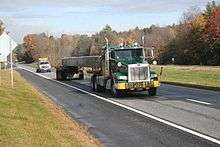

The legal dimensions and weights vary between countries and regions within a country. A vehicle which exceeds the legal dimensions usually requires a special permit which requires extra fees to be paid in order for the oversize/overweight vehicle to legally travel on the roadways. The permit usually specifies a route the load must follow as well as the dates and times during which the load may travel.
When a load cannot be dismantled into units that can be transported without exceeding the limitations in terms of the dimensions and/or mass, it is classified as an abnormal load. Another definition can be summarised as following: an abnormal indivisible load ('AIL') is one which cannot be divided into two or more loads for transporting (on roads).[1] Also, break bulk is used to define the freight that cannot be loaded into any ocean container or too large for air cargo.
Any road transport is framed by the CMR Convention (Convention on the Contract for the International Carriage of Goods by Road),[2] which relates to various legal issues concerning transportation of cargo, predominantly by lorries, by road.
Cargo loading and securement
According to the Federal Motor Carrier Safety Administration, National Highway Traffic Safety Administration, Large Truck Crash Causation Study[3] 7% of U.S. trucking accidents are caused by improper cargo securement or cargo shifts. Shifting cargo can cause the truck to destabilize or the load can fall off completely leading to serious public safety issues.
Load shifting is prohibited by law and it is the responsibility of the shipper, motor carrier, driver, receiver and the securing device manufacturer to ensure that the cargo is completely secured.[4]
International perspectives
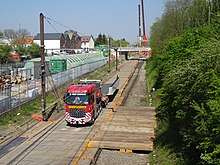

In a specific country the roads are built in a way that allows a vehicle with dimensions within the standard legal limits to safely (though not necessarily easily) drive and turn. Roads that do not allow large vehicles may be marked with the traffic signs. These may include per-axle load, height, width, or overall length limits.
Europe
Trucks must have special signs of "convoi exceptionnel" and lights that warn the oversized cargo. The escort car has also special signs, depending the country within it operates. Special permits are issued by local authorities to allow a transporter to operate on a public road for a limited period and for a certain and given route.[5] These permits can be annual in different European countries like Hungary, Austria, Germany, France etc.
Heavy transport companies tend to focus on renewables, civil and infrastructure, offshore, oil and gas, heavy engineering and power generation industries. Other companies across Europe have also collaborated to form the Route To Space Alliance[6] specifically for providing specialist logistics for AIL's in the Aerospace and Astrospace industries.
The Netherlands
Due to its strategic location, there are many Dutch-based special transport companies, but due to the relatively small size of the country, these companies, such as Van der Vlist have often started to spread further afield to increase their market, and take advantage of the freedom of movement offered through the EU.[7]
Romania
In Romania, if the total dimensions (truck+load) exceed 16.5 by 2.5 by 4 metres (54.1 ft × 8.2 ft × 13.1 ft) × 40 tonnes (39 long tons; 44 short tons) (or if it does not fit into a tilt truck), then a transport is considered out of gauge. A table of maximum dimensions and weight as well as best practices is available for European countries on the following industry resource site.[8] Transporting oversize loads requires, in some cases, escorts and police (for total weight of more than 80 tonnes (79 long tons; 88 short tons) or width over 5 metres (16 ft)). Also, a route survey is mandatory if the height is over 4.5 metres (15 ft).
Romania has an active market for special transporters where, as mentioned above, companies such as Schnell Trans, deal with international transportation projects. Trailers suitable for special loads have different characteristics depending on the number of axles, height from the ground to the platform, extensions or load capacity. Each of these trucks can carry loads such as trams, energy transformers, construction machines, metallic structures or wooden boxes/crates.[9]
United Kingdom
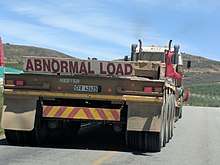
An abnormal load is defined as
- a load with a weight of more than 44 tonnes
- an axle load of more than 10 tonnes for a single non-driving axle and 11.5 tonnes for a single driving axle
- a width of more than 2.9 metres
- a rigid length of more than 18.65 metres
Anyone wishing to transport an abnormal load must notify the police, highway authorities and any on-route bridge and structure owners such as Network Rail.[10] Highways England operates a system known as "Electronic Service Delivery for Abnormal Loads" (ESDAL) for the purpose of supporting notifications.[11]
South Africa
New Zealand

In New Zealand, an oversize load is a vehicle and/or load that is wider than 2.50 m (8 ft 2 in) or higher than 4.25 m (13 ft 11 in). Overlength limits vary depending on the type and the configuration of vehicle, but the overall maximum forward distance (i.e. the length from the front of the vehicle to the centre axis of the rear axle set) is 9.5 m (31 ft 2 in), the overall maximum single vehicle length is 12.6 m (41 ft 4 in) (some buses can be longer), and the overall maximum combination length is 22.0 m (72 ft 2 in). Loads must be indivisible, except when the vehicle is oversize itself where it can carry divisible loads as long as the divisible load fits within the standard load limits. Permits are not required for oversize vehicles which are under 25.0 m (82 ft 0 in) long, under 5.00 m (16 ft 5 in) high, and fit within a set combination of width and forward distance; but they must comply with certain rules regarding piloting, travel times and obstructions.[12][13]
United States
In the United States, an oversize load is a vehicle and/or load that is wider than 8 ft 6 in (2.59 m). Each individual state has different requirements regarding height and length (most states are 13 ft 6 in or 4.11 m tall), and a driver must purchase a permit for each state he/she will be traveling through. In many states, a load must be considered "nondivisible" to qualify for a permit (i.e. an object which cannot be broken down into smaller pieces), although some states allow divisible loads to be granted permits.[14]
Signaling
In the United States, if required by the permit of the issuing authority, the owner of an Oversize Load often must hire a Pilot Car (flag or escort car) before the load can be moved on a public roadway. An Oversize Load may exceed one or all normal vehicle dimensions of weight, height, length, width and/or extend beyond the commonly-recognized perimeter of the Load vehicle. All Pilot Cars in an individual state must be uniformly identified with required durable, fade-resistant yellow OVERSIZE LOAD sign (on rooftop or the car’s position bumper) and amber flashing or rotating lights that are visible 360° and at least 100 feet (30 m) away. Those Pilot Cars may legally operate ahead of, behind or in any position relative to the Load that ensures the safe movement of the Load vehicle and all assisting Pilot, Police and Utility vehicles that are necessary for the move.
The certified Pilot Car Operator protects people, vehicles and property by several actions. The simple presence of a Pilot Car warns other drivers and pedestrians. The Lead (front position) Pilot Car often has a calibrated High Pole (and depending upon the state, a durable, fade-resistant yellow sign) bolted to its front bumper. The High Pole is designed to collide with overpasses, power lines and tree branches that may be above the lane in which the Pilot Car and the Load are operating. The Lead Pilot Car Operator transmits radio messages to the Load and other necessary vehicles of overhead obstructions or road conditions that require the Load to alter its path or stop. Finally, a Pilot Car Operator may park the Pilot Car just off the roadway and direct traffic with a reversible Slow/Stop sign or orange flags while wearing a bright vest and hard hat.
Generally, the Lead Pilot Car Operator functions to maintain an assured clear distance - 1⁄2 to 1 mile (0.8 to 2 km) - ahead of the Load. The Lead Pilot Car Operator frequently transmits his lane position, road name, lack of overhead obstruction up to and including a landmark or building and direction of travel. The Lead Pilot Car Operator is expected to observe any obstruction or complication that may require the Load to alter its path and transmit clear instructions to the Load and other necessary vehicles. Hearing the transmission from the Lead Pilot car, the Rear Pilot Car Operator ensures that the desired lane is clear and moves the Rear Pilot Car to operate in the now-clear lane. The Rear Pilot Car Operator transmit the clear lane availability to the Load. After passing the obstruction, the Lead Pilot car Operator informs the Load that the Lead Pilot car is now operating in a specific lane as it passes a specific landmark or building. The Rear Pilot Car Operator ensures and transmits that the desired lane is currently clear and moves the Rear Pilot Car to operate in the now-clear lane.
Typically, the edges of any oversize load must be marked to make them visible to drivers. During daytime the required marking is usually red flags, and during night white or yellow lights may be used. The hauling vehicle must have at least one flashing amber light in the front and back. Signs (yellow with black border in the United States, red and white diagonal stripes in the EU, and red and white vertical stripes in Canada), saying "Oversize load" must be put in the front and back of the vehicle.
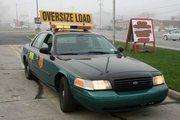
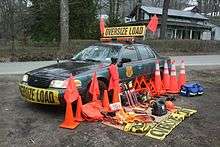
A Lead Pilot Car may follow a police car or Utility/Bucket Trucks. Pilot and trailing cars may be required also. Each must have at least one flashing amber light (visible 360 degrees at 500 feet (150 m)) on them. Their purpose is to observe all possible obstacles or impediments to the swift and safe transfer of the Load between two points and warn drivers about what's approaching. The Lead Pilot Car warns approaching drivers in the opposite lane, and the trailing car warns any candidates to overtake or pass the Load. The driver of the pilot car must have a 2-way radio communication system (often CB radio or handheld FRS radios) to alert all members of the move about any low bridges, wires, obstacles, etc. The driver of the trailing car is responsible for the safety(?) while passing obstacles or overtaking slower vehicles.
Pilot Car Operators may:
- Perform a Route Survey before the Load is moved
- Curb the Pilot Car to act as a Flagger
- Order the Load stopped for any reason
- Use the Pilot Car to block traffic from passing the load.
Since the driver of the truck cannot see the end of the trailer or vehicles that may be present in the next lane (because the load obstructs the mirrors), the general procedure is as follows: The truck driver sees an obstacle and signals with his left (or right, if in a left-side traffic country) turn signal (aka "blinker"). The driver of the trailing car waits until the adjacent lane is clear and moves so that the truck driver sees his or her car, thus preventing anyone from standing next to the truck. Then the trailing car moves a little back to stay clear of the truck's path. As soon as the trailer has cleared the obstacle, the trailing car again moves forward and flashes its headlights to inform the truck driver that it's safe to return in their lane. A pilot car driver may temporarily block traffic at intersections to ensure the safe passage of the truck.[15]
Hazards
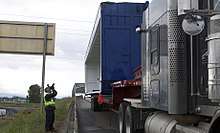
Oversize loads present a hazard to roadway structures as well as to road traffic. Because they exceed design clearances, there is a risk that such vehicles can hit bridges and other overhead structures. Over-height vehicle impacts are a frequent cause of damage to bridges, and truss bridges are particularly vulnerable, due to having critical support members over the roadway. An over-height load struck the overhead beams on the I-5 Skagit River bridge in 2013, which caused the bridge to collapse.[16]
Licensing
Different countries have different approaches to licensing oversize/overweight loads. Licenses may be issued for a specific load, for a period of time, or to a specific company. In most jurisdictions, the permit specifies the exact route a vehicle must take, and includes clearance warnings. However, in some places, such as Washington state, drivers are responsible for choosing their own route. The carrier can choose to obtain the required permits themselves or go through a permit service.[16]
See also
| Wikimedia Commons has media related to Oversized loads. |
References
- "Special Types (STGO) and abnormal loads". Commercialmotor.com. Retrieved 2012-08-29.
- "Convention on the Contract for the International Carriage of Goods by Road (CMR) – (Geneva, 19 May 1956)". Jus.uio.no. Retrieved 2012-03-10.
- "Large Truck Crash Causation Study". National Highway Traffic Safety Administration. 2007. Retrieved 18 April 2016.
- "The Nuts and Bolts of Cargo Loading and Securement Cases" (PDF). The Lawyer's Logbook. May 2014. Retrieved 18 April 2016.
- "Abnormal Loads Homepage". Abnormalloads.co.za. Retrieved 2012-03-10.
- Grieves, Shell. "Route To Space Alliance". www.route-to-space.eu. Retrieved 2017-02-15.
- "Van der Vlist European Offices".
- "Best practices for transporting abnormal loads in Europe". Returnloads.net. ]
- "wooden crates | Break bulk". Breakbulks.com. Retrieved 2012-03-10.
- Transporting abnormal loads, accessed 25 February 2018
- Register with ESDAL, accessed 25 February 2018
- "Vehicle dimensions and mass: guide to the factsheet 13 series (Factsheet 13)". NZ Transport Agency. April 2011. Retrieved 7 May 2012.
- "Overdimension vehicles and loads (Factsheet 53)". NZ Transport Agency. April 2011. Retrieved 7 May 2012.
- "Oversize and Overweight Load Permit Information". Federal Highway Administration. Retrieved 2009-04-18.
- "europa road". 11 December 2018.
- Mike Baker (June 20, 2013). "WSDOT knew trucks have clipped I-5 Skagit bridge for decades". The Seattle Times. Retrieved June 20, 2013.